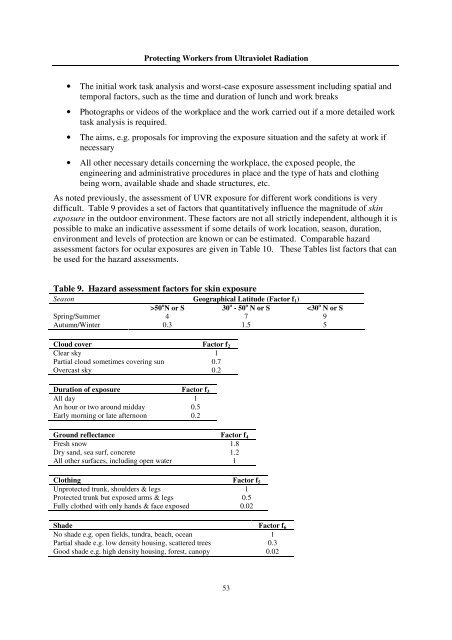Protecting Workers from Ultraviolet Radiation - icnirp
Protecting Workers from Ultraviolet Radiation - icnirp
Protecting Workers from Ultraviolet Radiation - icnirp
You also want an ePaper? Increase the reach of your titles
YUMPU automatically turns print PDFs into web optimized ePapers that Google loves.
<strong>Protecting</strong> <strong>Workers</strong> <strong>from</strong> <strong>Ultraviolet</strong> <strong>Radiation</strong><br />
• The initial work task analysis and worst-case exposure assessment including spatial and<br />
temporal factors, such as the time and duration of lunch and work breaks<br />
• Photographs or videos of the workplace and the work carried out if a more detailed work<br />
task analysis is required.<br />
• The aims, e.g. proposals for improving the exposure situation and the safety at work if<br />
necessary<br />
• All other necessary details concerning the workplace, the exposed people, the<br />
engineering and administrative procedures in place and the type of hats and clothing<br />
being worn, available shade and shade structures, etc.<br />
As noted previously, the assessment of UVR exposure for different work conditions is very<br />
difficult. Table 9 provides a set of factors that quantitatively influence the magnitude of skin<br />
exposure in the outdoor environment. These factors are not all strictly independent, although it is<br />
possible to make an indicative assessment if some details of work location, season, duration,<br />
environment and levels of protection are known or can be estimated. Comparable hazard<br />
assessment factors for ocular exposures are given in Table 10. These Tables list factors that can<br />
be used for the hazard assessments.<br />
Table 9. Hazard assessment factors for skin exposure<br />
Season Geographical Latitude (Factor f1)<br />
>50 o N or S 30 o - 50 o N or S



